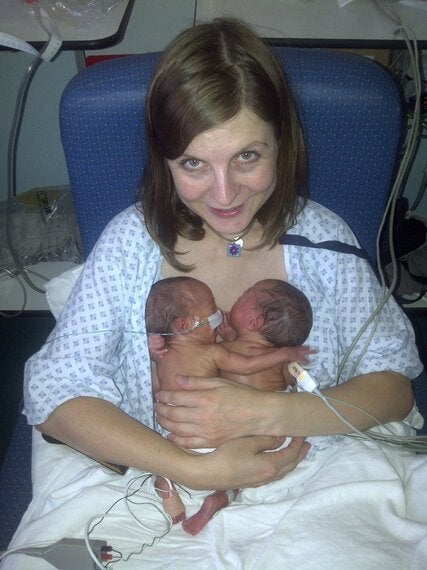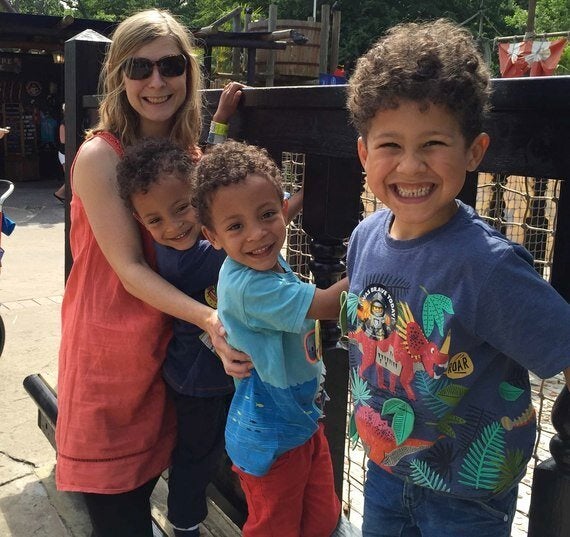Many identical twins are at risk before they're born from a rare condition, which can be fatal, called twin to twin transfusion (TTTS).
Luckily a new registry has been set up by Tamba (the twin and multiple births association) to help twins with TTTS. It will share information among hospitals about how to best treat this condition.
Here's my story.
DISCOVERING I was having identical twins at my 13-week scan was the shock of my life.
My partner Alex and I did not know that identical twins occur at random in three in 1,000 pregnancies. Our sonographer at University College Hospital explained that we were one of these "lucky" couples.
Four and half years later, I know we really are.
At that moment, we just wondered how we would cope with three under-twos, because we already had boisterous a 17-month-old boy, Raphy!
We were warned about the risks of TTTS. This condition affects twins, like ours, who share a placenta, and involves one baby getting more of the shared blood supply than the other. Every two weeks I would be scanned to make sure there were no growth differences between the babies, the main sign of TTTS.
All was fine at my 22-week scan. But a few days before my 24-week scan I had started to feel bloated and uncomfortable. Unfortunately, I had not yet met my consultant and the midwives and junior doctor I'd seen had not told me this was a TTTS warning sign.
My scan revealed I had acute and severe TTTS. My only choice - to save my babies' lives - was to have keyhole surgery the next day at King's College Hospital. This laser ablation surgery involves separating the blood vessels in the shared placenta to give each baby his own blood supply. Without this, both of my babies would die.
Though revolutionary, the procedure carries risks. I was told that in my case, there was just a 30% chance that both babies would survive. There was also a 30% chance one would die and a 30% chance both would die. Even if the operation was successful, there was still a risk of premature labour and a 10 - 15% chance of both babies suffering brain damage.
I was terrified, particularly because my little sister was born prematurely at 28 weeks and suffered cerebral palsy as a result.
The next day my consultant, George Attilakos, and a leading expert in fetal medicine, Prof Kypros Nicolaides, performed the surgery, which was guided by a camera. Alex and I watched on a TV screen in a room full of doctors from around the world, who were learning about the procedure.
Because of their abnormal blood flow, one of our babies (the donor) had no amniotic fluid left in his sac. The other (the recipient) had an excess of fluid on his abdomen and a stressed heart. As an excess 2.5 litres of amniotic fluid was drained from his sac, I saw his face and willed him to live. But we were told his chances were not great.
I learned that I should rest as much as possible and eat a high protein diet in an effort to increase both babies' weights. I was terrified.
A scan after five days showed our donor baby's amniotic fluid had returned. But his recipient brother still had fluid on his abdomen and a stressed heart.
A week later, a further scan found, against all the odds, that both our babies had recovered! In just two weeks I'd been through the worst and bests moment of my life.
Then at 29 weeks into my pregnancy, my waters broke at 6am. I got a cab to hospital and received a first course of steroids to mature the babies' lungs.
Although I was not in labour, I was told I would need to stay in hospital for the rest of my pregnancy. That night, as I tried to sleep, I realised I was having contractions every two minutes. Two hours later, the boys arrived naturally and very dramatically, within two minutes of each other.
I couldn't hold them afterwards, as they needed to be ventilated, then put on CPAP gas (continuous positive airway pressure) and rushed to the neonatal unit. They weighed 2lb 10oz each, which we were told was good for twins of this gestation.
We had not planned to give them "twin names". But after what they had been through, we called them Luca and Leo. To us these names mean "lucky" and "strong".
I was discharged from hospital after two days but they stayed for eight weeks, first at University College Hospital, then at our local hospital. During this time, I visited them every day, expressing milk around the clock to boost their tiny immune systems.

I now volunteer with Tamba (Twins and Multiple Births Association), supporting parents who have had a TTTS diagnosis. I hope their TTTS Registry will raise awareness about this condition among all medical staff.
It is vital all antenatal staff know every sign of TTTS. Unborn babies with a shared placenta must be closely monitored by a consultant to ensure they get the best treatment as early as possible.
My twins have passed all their developmental reviews and no one would know that they owe their lives to our NHS. But in another time, or another place, these healthy, exuberant and cuddly little creatures, would likely not be here.
I hope Tamba's TTTS Registry offers the chance that our miracle babies got to even more identical twins.

If you're expecting identical twins and would like to learn more about TTTS click here https://tamba.org.uk/ttts.
If you'd like to help support the TTTS Registry, which collects data on twins to aid research, please donate whatever you can by clicking here https://www.justgiving.com/fundraising/TTTSAppeal.